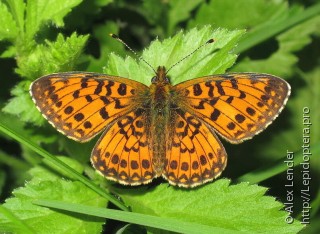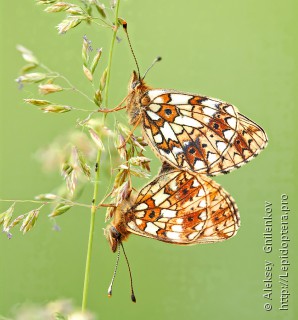Boloria selene
Taxonomy
class Insecta
Species name(s)
Boloria (Clossiana) selene (Denis & Schiffermuller, 1775) = Argynnis selene = Clossiana selene ([Denis & Schiffermuller], 1775) = Papilio selene [Schiffermüller], 1775 = euphrosyne (Bergsträsser, 1779) = euphrasia (Lewin, 1795) = silene (Haworth, 1803). [3, 9, 10, 85]
Small Pearl-bordered Fritillary.
urn:lsid:insecta.pro:taxonomy:8570
Expansion
This species marks on the maps: 4.
Zoogeographical regions
Palaearctic, Nearctic.
Russia regions
#1. Kaliningradsky; #2. Kolsky; #3. Karelsky; #4. Evropeisky Severo-Zapadny; #5. Nenetsko-Novozemelsky tundrovy; #6. Evropeisky Severo-Vostochny; #7. Evropeisky yuzhno-tayozhny; #8. Evropeisky Tsentralny; #9. Evropeisky Tsentralno-Chernozyomny; #10. Sredne-Volzhsky; #11. Volgo-Donsky; #13. Zapadno-Kavkazsky; #15. Severo-Uralsky; #16. Sredne-Uralsky; #17. Yuzhno-Uralsky; #18. Nizhneobsky; #19. Sredneobsky; #20. Yuzhno-Zapadnosibirsky; #21. Severo-Yeniseisky; #22. Krasnoyarsky; #23. Predaltaisky; #24. Gorno-Altaisky; #25. Tuvinsky; #26. Predbaikalsky; #27. Pribaikalsky; #28. Zabaikalsky; #31. Yuzhno-Yakutsky; #33. Severo-Okhotomorsky; #34. Kamchatsky; #35. Sredne-Okhotsky; #36. Sredne-Amursky; #37. Nizhne-Amursky; #38. Sakhalin; #39. Yuzhno-Kurilsky; #40. Primorsky.
Forewing length
18—20 mm.
Primary colors
Orange, Brown/Gray/Black, White.
Flight time
| January | February | March | April | May | June | July | August | September | October | November | December |
Larva lifespan
| January | February | March | April | May | June | July | August | September | October | November | December |
Detailed information with references
Taxonomy, synonyms and combinations
Distribution
Imago Habitus and Differences from alike species
General info about Imago
Imago lifespan
General info about Larva
Larva food plants / other food objects
Larva lifespan
Pupa
Egg
Overwintering stage
Subspecies of Boloria selene
- Clossiana selene albequina (Holland, 1928). [9]
- B. s. albequina W. Holland, 1928. [186]
- B. s. angustipennis Fuchs, 1899. [187]
- B. s. atrocostalis (Huard, 1927). [9]
- B. s. atrocostalis Huard, 1927. [186]
- B. s. castiliana Lowe, 1910. [187]
- B. s. chibiana (Matsumura, 1927). [9]
- B. s. chibiana Matsumura, 1927. [187]
- B. s. debrunneata Lempke, 1956. [187]
- B. s. dilutior (Fixsen, 1887). [9]
- B. s. flavescens Lempke, 1956. [187]
- B. s. flavopunctata Strand, 1900. [187]
- B. s. furoshonis Matsumura, 1929. [187]
- B. s. futura Reuss, 1929. [187]
- B. s. hyperborea Lingonblad, 1947. [187]
- B. s. infraclara Lempke, 1956. [187]
- B. s. infradefasciata Lempke, 1956. [187]
- B. s. lucetia Fruhstorfer, 1922. [187]
- B. s. marphisa Herbst, 1800. [187]
- B. s. meinhardi Sheljuzhko, 1929. [187]
- B. s. myrina (Cramer, [1777]). [9]
- B. s. nebraskensis (Holland, 1928). [9]
- B. s. onorensis Matsumura, 1925. [187]
- B. s. padimaxima Verity, 1933. [187]
- B. s. pales Bergstrasser, 1780. [187]
- B. s. postgentilinea Verity, 1933. [187]
- B. s. pseudoselene Rocci, 1940. [187]
- B. s. rinaldus Herbst, 1800. [187]
- B. s. sabulocollis (Kohler, 1977). [9]
- B. s. sachalinensis Matsumura, 1908. [187]
- B. s. selene. [9]
- B. s. selene Schiffermüller], 1775. [186]
- B. s. semicademis Lempke, 1956. [187]
- B. s. sugitanii Seok, 1938. [187]
- B. s. terraenovae (Holland, 1928). [9]
- B. s. thalia (Hübner, 1790). [9]
- B. s. thalia Esper, 1790. [187]
- B. s. tollandensis (Barnes & Benjamin, 1925). [9]
Authors
Initial species uploading to the site: Peter Khramov.
Text data: Peter Khramov.
The species characteristics formalization: Peter Khramov.
References
- [3] Каталог чешуекрылых (Lepidoptera) России. Под ред. С. Ю. Синёва. СПб.; М.: Товарищество научных изданий КМК, 2008
- [9] Tree of Life (funet.fi), 2012
- [10] de Jong, Y.S.D.M. (ed.) (2011) Fauna Europaea version 2.4 (faunaeur.org)
- [28] Moths and Butterflies of Europe and North Africa (leps.it), 2012
- [85] Lepidoptera species catalogue, Lepidoptera.ru, 2015
- [186] Integrated Taxonomic Information System on-line database, http://www.itis.gov
- [187] Species 2000, http://www.sp2000.org
Comments
Note: you should have a Insecta.pro account to upload new topics and comments. Please, create an account or log in to add comments
Boloria selene photos
































































All the photos of the species in large size
Please, create an account or log in to upload your photo

























